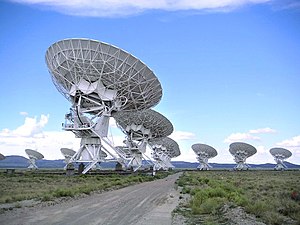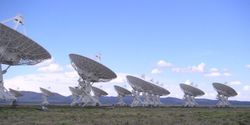
VLA Official
VLA Wikipedia
Astronomy Picture of the Day May 14 2006
The Very Large Array, one of the world's premier astronomical radio observatories, consists of 27 radio antennas in a Y-shaped configuration on the Plains of San Agustin fifty miles west of Socorro, New Mexico. Each antenna is 25 meters (82 feet) in diameter. The data from the antennas is combined electronically to give the resolution of an antenna 36km (22 miles) across, with the sensitivity of a dish 130 meters (422 feet) in diameter.

latitude = 34°04'43.497" north
longitude = 107°37'03.819" west
elevation = 2124 m (6970 ft)

Each antenna: 25 m (82 ft) in diameter, 230 tons.
The array: there are four configurations: A array, with a maximum antenna separation of 36 km; B array -- 10 km; C array -- 3.6 km; and D array -- 1 km. The telescopes are switched between these configurations every four months or so.

The resolution of the VLA is set by the size of the array -- up to 36 km (22 miles) across. At our highest frequency (43 GHz) this gives a resolution of 0.04 arcseconds: sufficient to see a golf ball held by a friend 150 km (100 miles) away. Of course, very few golf balls contain high-power radio transmitters.

Slew rates: 40° per minute in azimuth, 20° per minute in elevation
Minimum elevation angle: 8° above the horizon
Frequency coverage: 74 to 50,000 MHz (400 to 0.7 cm)
1 yorum:
Great 'cosmic nothingness' found
BBC News
Astronomers have found an enormous void in space that measures nearly a billion light-years across.
The team used data from the US National Radio Astronomy Observatory's VLA Sky Survey (NVSS) to make its discovery. The VLA - which stands for Very Large Array - is a collection of 27 radio telescopes in New Mexico.
It is empty of both normal matter - such as galaxies and stars - and the mysterious "dark matter" that cannot be seen directly with telescopes.
The "hole" is located in the direction of the Eridanus constellation and has been identified in data from a survey of the sky made at radio wavelengths.
Yorum Gönder